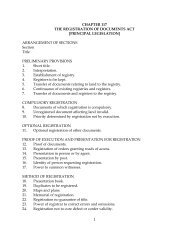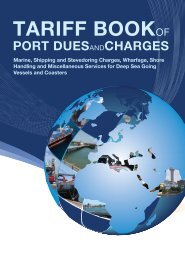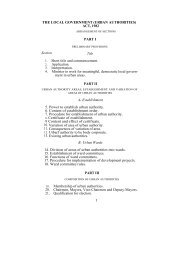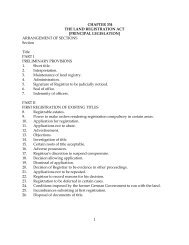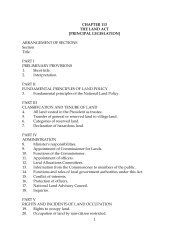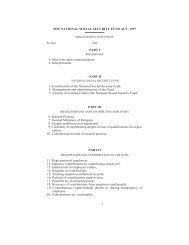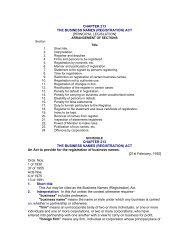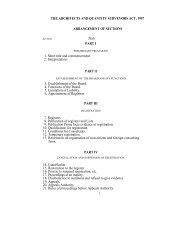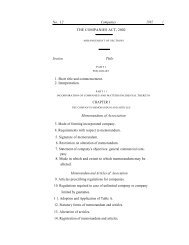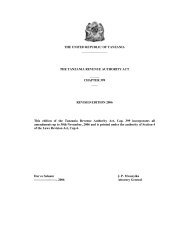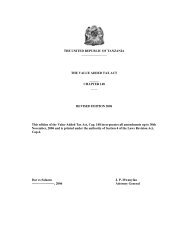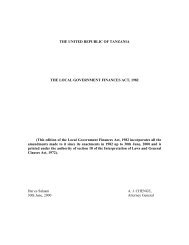(ppp) policy - Tanzania Investment Centre
(ppp) policy - Tanzania Investment Centre
(ppp) policy - Tanzania Investment Centre
You also want an ePaper? Increase the reach of your titles
YUMPU automatically turns print PDFs into web optimized ePapers that Google loves.
`<br />
THE UNITED REPUBLIC OF TANZANIA<br />
PRIME MINISTER’S OFFICE<br />
NATIONAL PUBLIC PRIVATE PARTNERSHIP (PPP) POLICY<br />
DAR ES SALAAM NOVEMBER, 2009<br />
‘‘Restricted Circulation’’
TABLE OF CONTENTS<br />
FOREWORD…………………………………………………………….………..….…ii<br />
LIST OF ABBREVIATIONS AND ACRONYMS ................................ .......... iv<br />
PPP DEFINITIONS…………………………….………………………….…...….....v<br />
CHAPTER ONE: INTRODUCTION ................................ .......................... 1<br />
1.1 The Review of Economic Performance................................................ 2<br />
1.2 Status of Public-Private Partnerships in <strong>Tanzania</strong> ................................. 3<br />
1.3 Challenges facing PPPs in <strong>Tanzania</strong> ..................................................... 4<br />
1.4 Rationale, Benefits and Scope ............................................................ 4<br />
1.4.1 Rationale……………………………………………………………………..…………4<br />
1.4.2 Benefits of Public-Private Partnerships……………………………….……..4<br />
1.4.3 The Scope…………………………………………………………….………………..5<br />
CHAPTER TWO: VISION, MISSION, GOAL AND OBJECTIVES……….……..6<br />
2.1 Vision ................................ ................................ .......................... 6<br />
2.2 Mission ............................................................................................. 6<br />
2.3 Goal .................................................................................................. 6<br />
2.4 Objectives ......................................................................................... 6<br />
CHAPTER THREE: POLICY ISSUES AND STATEMENTS.……….…………7-13<br />
CHAPTER FOUR: IMPLEMENTATION FRAMEWORK ............................. 14<br />
4.1 Overview ............................................................................................. 14<br />
4.2 Scope of Implementation Framework .................................................... 14<br />
4.3 PPPs Identification Process ................................................................... 15<br />
4.4 Roles and Functions of Various Stakeholders and Actors ......................... 15<br />
4.5 Monitoring and Evaluation .................................................................... 15
FOREWORD<br />
The Government recognizes the role of private sector in bringing about socio-economic<br />
development through investments. Public-Private Partnership (PPP) frameworks<br />
provides important instrument for attracting investments. Indeed, Public-Private<br />
Partnerships (PPPs) have been identified as viable means to effectively address<br />
constraints of financing, management and maintenance of public goods and services.<br />
Additionally, PPPs can enable the Government to fulfill its responsibilities in efficient<br />
delivery of socio-economic goods and services by ensuring efficiency, effectiveness,<br />
accountability, quality and outreach of services.<br />
The concept of PPP entails an arrangement between the public and private sector<br />
entities whereby the private entity renovates, constructs, operates, maintains, and/or<br />
manages a facility in whole or in part, in accordance with specified output<br />
specifications. The private entity assumes the associated risks for a significant period of<br />
time and in return, receives benefits and financial remuneration according to agreed<br />
terms. PPPs constitute a cooperative venture built on the synergy of expertise of each<br />
partner that best meets clearly defined public needs through the most appropriate<br />
allocation of resources, risks and rewards.<br />
Most PPPs implemented in <strong>Tanzania</strong> are concession arrangements for running existing<br />
enterprises with limited provisions for rehabilitation and new investments. It is<br />
noteworthy that in the case of services, PPPs have been implemented successfully by<br />
Faith Based Organizations (FBOs) in education, health and water sectors for many<br />
years. However, in the case of other sectors, the performance has been mixed largely<br />
due to the complexity of such projects and lack of clear guidelines on the criteria for<br />
public and private sector partnership.<br />
Private sector participation in areas previously treated as the monopoly of the public<br />
sector has made major contributions to increasing the pace of growth and development<br />
in many countries. In contemplating to utilize this instrument, <strong>Tanzania</strong> encounters a<br />
number of challenges including:<br />
(i) Lack of comprehensive <strong>policy</strong>, legal and institutional frameworks that provide<br />
clear guidelines and procedures for development and implementation of PPPs;<br />
(ii) Lack of realistic and comprehensive technical, socio-economic and commercial<br />
feasibility analysis which leads to poor project design;<br />
(iii) Inadequate enabling environment which includes lack of long-term financing<br />
instruments and appropriate risk sharing mechanisms; and<br />
(iv) Insufficient capacity negotiations, procurement, implementation and<br />
management of PPPs.<br />
To achieve the goal of poverty reduction by 2025, <strong>Tanzania</strong> has chosen to initiate and<br />
implement measures for the realization of green revolution by adopting KILIMO<br />
KWANZA resolution. This is the development vehicle for modernizing agriculture and<br />
ii
thereby attaining economic transformation needed for sustained poverty reduction.<br />
Transformation of agriculture will depend on heavy investment in the development of<br />
capacity for delivery of PPPs to contribute to the attainment of Vision 2025. In this<br />
regard, the government recognizes that, greater private sector participation through<br />
PPPs in providing efficient, reliable and affordable socio-economic services, is<br />
fundamental for green revolution and broad based growth and sustainable poverty<br />
reduction. The creation and operation of an appropriate enabling environment to guide<br />
public and private sectors, donor community and other stakeholders in PPPs will go a<br />
long way in contributing to the achievement of our development goals. Furthermore,<br />
the national PPP Policy will serve as an important intervention to accelerate economic<br />
empowerment by ensuring that <strong>Tanzania</strong>ns are adequately empowered in various PPPs<br />
interventions. In this spirit, a cross-section of various stakeholders have been involved<br />
in the development of this <strong>policy</strong>; and we look forward for the necessary collaboration<br />
for its implementation so that the noble goal of economic growth and eliminating<br />
poverty in <strong>Tanzania</strong> is achieved.<br />
Hon. Mizengo P. Pinda (MP)<br />
Prime Minister of the United Republic of <strong>Tanzania</strong><br />
iii
LIST OF ABBREVIATIONS AND ACRONYMS<br />
BBO<br />
BLT<br />
BOO<br />
BOOT<br />
BOT<br />
CBOs<br />
DB<br />
DBO<br />
DBFO/M<br />
DBOM<br />
DPs<br />
EIA<br />
FBOs<br />
FDI<br />
GDP<br />
HBS<br />
IPTL<br />
LGAs<br />
MDAs<br />
M & E<br />
NGOs<br />
NSGRP<br />
ODA<br />
PPA<br />
PPP(s)<br />
SSA<br />
TISP<br />
TRL<br />
USD<br />
Buy-Build-Operate<br />
Build-Lease-Transfer<br />
Build-Own-Operate<br />
Build-Own-Operate-Transfer<br />
Build-Operate-Transfer<br />
Community Based Organizations<br />
Design-Build<br />
Design-Build-Operate<br />
Design-Build- Finance-Operate/Maintain<br />
Design-Build-Operate- Maintain<br />
Development Partners<br />
Environmental Impact Assessment<br />
Faith Based Organizations<br />
Foreign Direct <strong>Investment</strong><br />
Gross Domestic Product<br />
Household Budget Survey<br />
Independent Power <strong>Tanzania</strong> Limited<br />
Local Government Authorities<br />
Ministries, Departments and Agencies<br />
Monitoring and Evaluation<br />
Non-Governmental Organizations<br />
National Strategy for Growth and Reduction of Poverty<br />
Official Development Assistance<br />
Public Procurement Act<br />
Public-Private Partnership(s)<br />
Sub-Saharan Africa<br />
Transport <strong>Investment</strong> Sector Programme<br />
<strong>Tanzania</strong> Railways Limited<br />
United States Dollar<br />
iv
PPP Key Concepts<br />
Public-Private Partnerships (PPPs)<br />
The concept of PPP entails an arrangement between public sector and private sector<br />
entities whereby the private entities renovate, construct, operate, maintain, and/or<br />
manage a facility in whole or in part in accordance with output specifications. The<br />
private entity assumes the associated risks for a significant period of time and in return,<br />
receives benefits/financial remunerations according to agreed terms; which can be in<br />
the form of tariffs or user charges. PPP is therefore a cooperative venture built on the<br />
expertise of each partner that best meets clearly defined public needs through the most<br />
appropriate allocation of resources, risks and rewards.<br />
PPPs for Operation of Existing Public Assets: Service, Management, Leasing<br />
Contracts and Concessions<br />
In a service contract, the government contracts with a private entity to provide services<br />
the government previously performed. A management contract defers from service<br />
contract in that the private entity is responsible for all aspects of operation and<br />
maintenance of the facility under contract. A Lease Contract provides an alternative<br />
arrangement whereby the government grants a private entity a lease hold interest in an<br />
asset and the private partner operates and maintains the assets in accordance with the<br />
terms of the lease. A third variant is a concession arrangement whereby the<br />
government grants private entity exclusive rights to provide, operate and maintain an<br />
asset over a long period of time in accordance with performance requirements set forth<br />
by government. The public sector retains ownership of original asset while the private<br />
operator retains ownership over any improvements made during contract period.<br />
PPPs for Development and Operations of New Facilities<br />
The core issue in this category is the development of new facility and its ownership over<br />
time. Focus is on design and construction of required new facilities, and hence<br />
emphasis on the terms: construction, operations and ownership. The resulting options<br />
include: Design and Build (DB); Design Build and Operate (DBO); Build, Operate and<br />
Transfer (BOT); Build, Lease and Transfer (BLT); Design, Build, Finance and<br />
Operate/Maintain (DBFO/M); Build, Own and Operate (BOO); and Buy, Build and<br />
Operate (BBO).<br />
Design-Build (DB): Under this model, the government contracts with the private<br />
partner to design and build a facility in accordance with the requirements set by the<br />
government. After completing the facility, the government assumes responsibility for<br />
operating and maintaining the facility.<br />
1
Design-Build-Operate (DBO): Under this model, the government contracts with the<br />
private partner to design and build a facility in accordance with the requirements set by<br />
the government. After completing the facility, the ownership of the facility remains with<br />
the public sector while the private partner operates the facility according to public<br />
performance requirements. The operator is also responsible for replacing the assets<br />
whose life has expired.<br />
Design-Build-Operate- Maintain (DBOM): This combines the responsibilities of<br />
design-build procurements with the operations and maintenance of a facility for a<br />
specified period by private sector partner. At the end of that period, the facility is<br />
transferred back to the public sector. This model is also referred to Build-Operate-<br />
Transfer (BOT).<br />
Build-Lease-Transfer (BLT): After building the asset, the concessionaire rents or<br />
leases it from Government and eventually transfers it again.<br />
Design-Build- Finance-Operate/Maintain (DBFO or DBFM): Under this model,<br />
the private sector designs, builds, finances, operates/or maintains a new facility under a<br />
long term lease. At the end of the lease term, the facility is transferred to the public<br />
sector.<br />
Build Own Operate (BOO): In this model, the government grants the right to<br />
finance, design, build, operate and maintain a project to a private entity, which retains<br />
ownership of the project. The private entity is not required to transfer the facility back<br />
to the government.<br />
Build-Own-Operate-Transfer (BOOT): In this model, the government grants a<br />
franchise to a private partner to finance, design, build and operate a facility for a<br />
specified period of time. Ownership of the facility is transferred back to the public sector<br />
at the end of that period.<br />
Buy-Build-Operate (BBO): BBO is a form of asset sale that includes a rehabilitation<br />
or expansion of an existing facility. The government sells the asset to the private sector<br />
entity, which then makes the improvements necessary to operate the facility in a<br />
profitable manner.<br />
Unsolicited Bids: These are bids for which a private entity or an individual identifies<br />
and submits a proposal to the competent authority. The proposal is examined using<br />
defined criteria and if it qualifies it is designated as a PPP. Such bids emanate from the<br />
fact that potential PPPs may not always be known and tendered to the public for<br />
submission of bids.<br />
Solicited Bids: These are bids for which a competent authority identifies for private<br />
participation and announces a request for proposal, leading to the selection of the<br />
successful bidder.<br />
1
CHAPTER ONE<br />
INTRODUCTION<br />
1.1 The Review of Economic Performance<br />
The Government of <strong>Tanzania</strong> has been implementing socio-economic reforms aimed at<br />
stimulating high rates of economic growth for the achievement of poverty reduction<br />
goals, resulting in substantial economic performance. The reforms include fiscal and<br />
monetary policies, privatization of state owned enterprises, trade liberalization,<br />
improvement of the business environment and strengthening of public expenditure<br />
management.<br />
These reforms have resulted into encouraging performance of the economy. <strong>Tanzania</strong><br />
has experienced steady recovery in growth from 2 percent per annum from 1990 -<br />
1995; to 4 percent during the period 1995 - 2000. Macro-economic performance over<br />
the period 2001 – 2007 was impressive: the GDP growth during this period averaged<br />
7.0 percent per annum; and inflation averaged 6.5 percent over the same period.<br />
Inflation rate for <strong>Tanzania</strong> was 7.2 percent in 2008, and rose to 12.1 percent by<br />
September, 2009. This was caused by rising fuel prices, drought, and the global<br />
financial crisis. However, <strong>Tanzania</strong> needs to sustain a high GDP growth rate of 10<br />
percent or more in order to achieve the goals of the National Development Vision 2025.<br />
<strong>Investment</strong>s have also increased from 17.6 percent of GDP in 1995 to 26.3 percent in<br />
2008; while savings as a percentage of GDP remained at a low level of 15.4 in 2008.<br />
However, credit to the private sector has maintained an upward trend from 4.6% of<br />
GDP in 2001 to 13.8% in 2007, but it remains low compared to other developing<br />
countries. Foreign Direct <strong>Investment</strong> (FDI) has increased from USD 150.86 million in<br />
1995 to USD 717.7 million in 2008. This growth of FDI is still very small when compared<br />
to global and Sub –Saharan Africa (SSA) average, as well as in terms of the big demand<br />
for the attainment of robust economic growth. Challenges to attract more FDI include<br />
improving the business and investment climate, specifically, improving and expanding<br />
the transportation system (i.e roads, ports, and railways), utilities (power, water and<br />
sanitation services) and legal and regulatory framework as well as financial services.<br />
Other challenges include low value addition in productive and economic services<br />
sectors, other supply side constraints and market access.<br />
As far as poverty trend is concerned, data from the HBS 2000/01 and 2007 show a<br />
limited decline in income poverty levels in all areas. According to the Poverty and<br />
Human Development Report (2009), the proportion of the population below the basic<br />
needs poverty line slightly declined from 35.7% to 33.6%, and the incidence of food<br />
poverty fell from 18.7% to 16.6%. Poverty is mainly a rural phenomenon whereby<br />
37.6% of rural households live below the basic needs poverty line, compared with 24%<br />
of households in urban areas and 16.4% in Dar es Salaam.<br />
2
To address these and other existing socio-economic challenges, <strong>Tanzania</strong>, like most<br />
other developing countries, is currently facing huge budgetary needs and therefore<br />
needs to address the constraint of a narrow domestic tax base so as to bridge the<br />
resource gap for implementing critical development needs. The investment<br />
requirements to attain high growth and reduce poverty are enormous and cannot be<br />
met from the public sector and Official Development Assistance (ODA) alone in a timely<br />
manner. Hence, participation of private capital is key to resolving the prevailing<br />
budgetary resource constraints. To sustain progressive socio-economic development,<br />
therefore, <strong>Tanzania</strong> requires innovative tools for financing development programmes in<br />
order to expand its production frontier as well as to improve economic competitiveness.<br />
The <strong>Tanzania</strong> National Development Vision 2025 requires the Government to support<br />
and stimulate various actors participating in economic growth, by encouraging the<br />
private sector to undertake investments in infrastructure and services development.<br />
Such investments can be achieved through PPPs frameworks. Indeed, PPPs have<br />
proven to provide effective alternate source of financing, management and<br />
maintenance of public sector projects. Additionally, PPPs enable the Government to<br />
streamline its responsibilities in providing socio-economic goods and services, and this<br />
enhances efficiency, accountability, quality of service and wide outreach.<br />
Given the absence of <strong>policy</strong>, PPPs have been implemented either by virtue of existing<br />
laws such as the Public Corporation Act of 1992 as amended by Act No. 16 of 1993, or<br />
through the mandate emanating from structural reform policies. This has created<br />
several challenges that have to be addressed by creating specific legislation and<br />
regulatory framework for PPPs.<br />
1.2 Status of Public-Private Partnerships in <strong>Tanzania</strong><br />
Most PPPs in <strong>Tanzania</strong> are being undertaken through the privatization programme, and<br />
have mainly involved direct service delivery. New investments in physical infrastructure<br />
development using PPP basis are low, a few exceptions are in the power and<br />
communications sectors. There has been a limited success.<br />
PPPs implemented in <strong>Tanzania</strong> are concession agreements for running existing<br />
enterprises with limited provisions for rehabilitation and new investments. Following<br />
adoption of liberalization policies, there has been an increased involvement of the<br />
private sector in investment and provision of services which previously were being<br />
provided by the Government. For example, in the case of services, PPPs have been<br />
implemented successfully by Faith Based Organizations (FBOs) in education, health and<br />
water sectors for many years. In the case of other sectors, the performance has been<br />
mixed largely due to the complexity of such undertakings and lack of clear guidelines on<br />
the criteria for public and private sector partnership.<br />
3
1.3 Challenges facing PPPs in <strong>Tanzania</strong><br />
Private sector participation in areas previously treated as prerogatives of public sector<br />
has been of significant boost in many countries. While <strong>Tanzania</strong> is contemplating to<br />
utilize this avenue it has been faced with the following challenges:-<br />
(i) Lack of comprehensive <strong>policy</strong>, legal and institutional frameworks that provide<br />
(ii)<br />
clear guidelines and procedures for development and implementation of PPPs;<br />
Lack of analysis capacity to assess investment proposals leading to poor project<br />
designs and implementation;<br />
(iii) Inadequate enabling environment which includes lack of long-term financing<br />
instruments and appropriate risk sharing mechanisms;<br />
(iv) Insufficient capacity in negotiations, procurement, implementation and<br />
management of PPPs;<br />
(v) Inadequate risk sharing mechanisms that often lead to the public sector carrying<br />
the full burden of risks;<br />
(vi) Inadequate mechanisms for recovery of private investors’ capital as well as<br />
impact on national development programmes that depend on the project’s<br />
performance; and<br />
(vii) Lack of public awareness about PPPs and their benefits.<br />
1.4 Rationale, Benefits and Scope<br />
1.4.1 Rationale<br />
<strong>Tanzania</strong> needs to utilize all available options to attract increased private sector<br />
investments including PPPs. This is very essential in order to achieve the Millennium<br />
Development Goals, National Development Vision 2025 and the National Strategy for<br />
Growth and Reduction of Poverty (NSGRP) goals. <strong>Tanzania</strong>, like most other developing<br />
countries, is faced with huge budgetary constraints which needs to be addressed<br />
through greater participation of the private sector.<br />
There are weaknesses in various stages of PPPs from procurement to implementation<br />
due to lack of appropriate <strong>policy</strong> guidelines and corresponding legal and institutional<br />
framework, hence the critical need for adopting a PPP <strong>policy</strong>.<br />
1.4.2 Benefits of Public-Private Partnerships<br />
The PPP arrangement is beneficial to a country and justifiable in view of the potential<br />
benefits that accrue to all parties. The potential benefits include:<br />
(i)<br />
(ii)<br />
Facilitating creative and innovative approaches in stimulating private sector to<br />
engage in specific PPPs; with the government allowing bidders to compete on<br />
the basis of their ability to develop unique and creative approaches to the<br />
delivery of a required output;<br />
Enhancing government’s capacity to develop integrated solutions that<br />
effectively addresses public needs;<br />
4
(iii) Reduced costs of implementation and realization of quality products and<br />
services attributable to economies of scale and operating efficiency;<br />
(iv) Accessing technical and managerial expertise, financial resources and<br />
technology from the private sector;<br />
(v) Facilitating large scale capital injections while reducing public debt and<br />
dependency on aid;<br />
(vi) Better responsiveness to consumer needs and satisfaction of those needs;<br />
(vii) Fostering economic growth by developing new investment opportunities and<br />
increasing provision of public goods and services; and<br />
(viii) Ensuring fulfillment of the best interest of the public and private sector through<br />
an appropriate allocation of risks and returns.<br />
1.4.3 The Scope<br />
In <strong>Tanzania</strong>’s case Public-Private Partnership is a multi-dimensional concept that should<br />
be pursued from the perspective of national macroeconomic and sectoral policies with<br />
emphasis on the following:<br />
(i)<br />
(ii)<br />
(iii)<br />
(iv)<br />
(v)<br />
(vi)<br />
(vii)<br />
Establishment of enabling Policy, Legal and Regulatory Framework for promotion<br />
of PPPs;<br />
Implementation strategy outlining among others, activities, roles of stakeholders,<br />
resource requirements and time frame;<br />
Operational guidelines and standards for the development of PPPs<br />
Identification of the nature of private sector participation, extent and conditions<br />
for Government support and risk-sharing mechanisms;<br />
Mechanism for coordination and promotion of PPPs;<br />
Identification of appropriate performance indicators, skills and competencies<br />
required to achieve PPPs in relation to best practice as well as feedback and<br />
control mechanisms; and<br />
Monitoring and Evaluation system.<br />
Participation in PPPs may take place in both productive and socio-economic<br />
services sectors including, but not limited to the following: Agriculture,<br />
Infrastructure, Manufacturing, Education, Health, Natural resources, Tourism, Energy,<br />
Mining, Water, Land development, Environment and solid waste management,<br />
Appropriate defense infrastructure, Sports, Communication, Information and<br />
Communication Technology (ICT), Trade, Entertainment and recreation and Irrigation.<br />
5
CHAPTER TWO<br />
VISION, MISSION, GOAL AND OBJECTIVES<br />
Realisation of the National Development Vision 2025, requires achieving and sustaining<br />
a high rate of shared growth based on building a strong and competitive economy. The<br />
private sector has a key role in the achievement of this goal; and PPPs provide a<br />
powerful instrument among others in attaining this goal.<br />
2.1 Vision<br />
Efficient and sustainable PPPs for the delivery of reliable and affordable socio-economic<br />
goods and services.<br />
2.2 Mission<br />
Creating an enabling environment for promoting PPPs to achieve sustainable high and<br />
broad-based economic growth.<br />
2.3 Goal<br />
Contribute to national poverty reduction objective through delivery of competitive and<br />
sustainable PPPs.<br />
2.4 Objectives<br />
2.4.1 Main Objective<br />
The main objective is to promote private sector participation in the provision of<br />
resources for PPPs enterprises in terms of investment capital, managerial skills and<br />
technology.<br />
2.4.2 The Specific Objectives<br />
i. To develop an enabling legal and institutional framework to guide<br />
investments in PPPs;<br />
ii. To implement effective strategy showing specific obligations and rights for<br />
various stakeholders;<br />
iii. To introduce fair, equitable, transparent, competitive and cost-effective<br />
procurement processes for PPPs;<br />
iv. To adopt operational guidelines and criteria for PPPs;<br />
v. To attract resources for development of PPPs;<br />
vi. To develop institutional capacities for technical analysis and negotiation of<br />
PPPs and associated contracts; and<br />
vii. To establish efficient and quality socio-economic PPPs.<br />
6
CHAPTER THREE<br />
POLICY ISSUES AND STATEMENTS<br />
3.1 Issue: Comprehensive Policy, Legal and Institutional Frameworks for PPPs<br />
Most sector policies underscore the role of public-private partnerships in addressing the<br />
need to stimulate higher rates of economic growth. This is due to increasing demand<br />
for financial and technical resources compared to available public resources needed to<br />
develop PPPs. Experience shows that effective legal and institutional framework for<br />
coordination and implementation of PPP Policy is crucial for mobilizing private sector<br />
resources. However, implementation of PPPs in <strong>Tanzania</strong> has not been very impressive<br />
although there has been few success stories particularly in the case of health and<br />
education sectors. This is caused by among others, lack of comprehensive <strong>policy</strong>, legal<br />
and institutional framework for PPPs. The big demand for development needs makes it<br />
imperative for <strong>Tanzania</strong> to adopt the PPP instrument in order to achieve its<br />
development goals.<br />
Objective: To put in place an enabling <strong>policy</strong>, legal and institutional framework for<br />
PPPs.<br />
Policy Statement: The Government in collaboration with Stakeholders will:<br />
i. Enact new legislation, amend related existing laws and put in place<br />
regulations and operational guidelines for PPPs. The enabling<br />
environment will ensure transparent and clear administrative<br />
mechanisms;<br />
ii.<br />
Establish a central PPP Coordination Unit under the Ministry responsible<br />
for investment and private sector development and a PPP finance Unit<br />
under Ministry responsible for finance.<br />
It is important that clear linkages of roles with the implementing<br />
Ministries and appropriate bodies at the Local Government will be<br />
observed in PPP laws and relevant regulations.<br />
7
3.2 Issue: Adequacy of Resources for Development and Maintenance of<br />
PPPs<br />
Considering the limitation of public resources, there is a need to create enabling<br />
environment to mobilize private sector resources to augment public resources for<br />
development activities. The Private sector can bring in unique strengths and the<br />
required resources. The PPP approach provides a feasible option for governments in the<br />
developing countries, including <strong>Tanzania</strong>, to bridge the gap on resources required for<br />
socio-economic development.<br />
Policy Objective<br />
To put in place an enabling environment to generate and mobilize adequate financial<br />
and technical resources for PPPs.<br />
Policy Statement:<br />
Policy Statement: The Government in collaboration with Stakeholders will:<br />
Put in place appropriate instruments to enable the private sector to mobilize<br />
resources for the development of PPPs.<br />
3.3 Issue: Procurement Process for PPPs<br />
Some PPPs have not been as successful as envisaged partly due to pitfalls in the<br />
procurement process. International best practice requires both solicited and unsolicited<br />
bids be subjected to competitive procurement processes with details available for public<br />
scrutiny and accountability. The emphasis of having a competitive procurement process<br />
is to ensure fair, equitable, transparent, competitive and cost-effective procurement. In<br />
addition, all parties should expose themselves to public scrutiny in order to avoid<br />
conflict of interests and to safeguard national interests.<br />
Objective: To ensure PPPs are transparently and competitively procured.<br />
Policy Statement: The Government in collaboration with Stakeholders will:<br />
Ensure that the PPPs are procured through open competitive bidding process in<br />
accordance with the Public Procurement Act (PPA) No. 21 of 2004 and as may be<br />
amended from time to time. However, unsolicited bids will also be accepted and<br />
treated on case to case basis as provided for by relevant laws.<br />
8
3.4 Issue: Feasibility of PPPs<br />
Most PPPs undertaken so far were not subjected to comprehensive analysis of socioeconomic<br />
viability and implications on government budgetary resources. International<br />
best practice requires that PPPs be subjected to rigorous technical, financial, economic<br />
and social feasibility. In all investment evaluation decisions and subsequent project<br />
procurement decisions, all parties should consider public interest matters such as<br />
accountability, environmental protection, health and safety, consumer rights, public<br />
access, equity and sustainability.<br />
Projects qualifying for PPP should also be bankable and meet the value for money<br />
investment criteria. This is imperative considering that financiers will be reluctant to<br />
commit finances when a project entails high participation costs, unreasonable risk<br />
transfer or lengthy and complex contract negotiations. It is therefore critical to ensure<br />
that project developers/investors are assured of steady and predictable income streams<br />
over the lifetime of the project in order to guarantee service delivery.<br />
Policy Statement: The Government in collaboration with other stakeholders will:<br />
Put in place operational guidelines and procedures to ensure that PPPs are<br />
technically, financially, economically and socially viable. In addition, all parties will<br />
ensure that PPPs are bankable and provide value for money.<br />
3.5 Issue: Negotiation of the PPPs and Approval<br />
There are underlying challenges and risks in negotiation and approval processes for<br />
PPPs, and this call for well guided negotiation and approval system. The experience of<br />
PPPs implemented in the energy, minerals, water, and transport sectors shows that<br />
there have been underlying poor contractual arrangements. Therefore, there is a need<br />
to strengthen the existing system to safeguard the national goals, concerns and<br />
interests.<br />
Policy Objective: To improve negotiations and approval processes for PPPs.<br />
Policy Statement: The Government in collaboration with Stakeholders will:<br />
Provide a comprehensive framework for negotiation and approval of PPPs.<br />
3.6 Issue: Risk Allocation Mechanism for PPPs<br />
Risk allocation is normally based on the “optimal risk allocation” by allocating to the<br />
party most capable of managing that particular risk. Efficient and optimal risk sharing is<br />
9
an essential element in the design and implementation of PPPs. This is important to<br />
safeguard returns to all parties and ensure sustainability. The major reason to have<br />
appropriate risks sharing mechanism is that the parties involved in PPPs have differing<br />
interests and objectives. Therefore, a cost effective risk sharing mechanism is<br />
fundamental for PPPs’ success.<br />
Policy Objective:<br />
To ensure equitable and optimal risk allocation for PPPs<br />
Policy Statement: The Government in collaboration with Stakeholders will:<br />
Provide necessary risk sharing framework in PPPs investments to ensure that risks<br />
are assigned to the party most suited to manage them; and that the risk allocation<br />
is cost-efficient and optimal.<br />
3.7 Issue: <strong>Investment</strong> Opportunities and Promotion<br />
Lack of a guideline for investors to exploit various PPP opportunities existing in different<br />
sectors of the economy hinders investments in PPPs. The guideline will provide<br />
guidance to private sector participation in PPPs to broaden investment opportunities,<br />
innovation and technology transfer. In addition, PPPs must be promoted for all parties<br />
concerned to benefit.<br />
Policy Objective:<br />
To widen the scope of investment opportunities and the promotion of PPPs.<br />
Policy Statement: The Government in collaboration with Stakeholders will:<br />
Formulate PPP guidelines to facilitate smooth implementation of PPPs.<br />
3.8 Issue: Awareness Creation<br />
PPP is a relatively new concept in <strong>Tanzania</strong> although it has been applied through<br />
divestiture of public enterprises. There is a need, therefore, of conducting awareness<br />
and sensitization campaigns on PPP aspects, in order to broaden and deepen its<br />
understanding among the public.<br />
In this regard, awareness creation and sensitization on PPPs should be extended to all<br />
segments of society and stakeholders including government leaders, parliamentarians,<br />
10
civil servants, investors, civil societies, private sector and public in general. This is one<br />
of means to stimulate participatory <strong>policy</strong> implementation, monitoring and evaluation.<br />
Policy Objective:<br />
To create public awareness to stakeholders on PPPs.<br />
Policy Statement: The Government in collaboration with Stakeholders will:<br />
Prepare a communication strategy for awareness creation and consensus building<br />
for acceptance of PPPs and their outcomes by all stakeholders including government<br />
leaders, parliamentarians, public officials, investors and the general public. In this<br />
process, all stakeholders will also be educated on the benefits of PPPs and<br />
associated costs and risks.<br />
3.9 Issue: Capacity Building and Technological Transfer<br />
The existing capacity to deal with PPPs is inadequate and therefore, there is a need for<br />
major capacity building programme in all areas of PPP designs and implementation.<br />
These areas include negotiations, feasibility, procurement, management and other<br />
implementation aspects. In addition, the development of PPPs is a complex task which<br />
requires diverse skills in areas including technical, economic, financial, legal and<br />
procurement disciplines. International best practices demonstrate the need to<br />
undertake capacity building measures for effective implementation of PPPs,<br />
encompassing also change of mindset to all parties and stakeholders. Human resources<br />
development is essential for those involved in PPPs given the fact that PPP practice is<br />
dynamic and needs latest best practice.<br />
Parallel with efforts to enhance capacity building, technological transfer is needed for<br />
effective and efficient implementation of PPPs. Technology transfer in PPPs will be<br />
encouraged as the process of sharing skills, knowledge, designs and management of<br />
various PPP contracts and other implementation aspects. This will be encouraged to<br />
ensure that scientific and technological developments is accessible to a wider range of<br />
users.<br />
Policy Objective<br />
To ensure sustainable capacity building and technological transfer for PPPs.<br />
11
Policy Statement: The Government in collaboration with Stakeholders will:<br />
i. Design and implement a strategy for development of human resources<br />
in PPPs;<br />
ii. Build on the experiences of successful PPPs implemented in <strong>Tanzania</strong><br />
such as in health and education sectors, and also from international best<br />
practices; and<br />
iii. Encourage interventions for technological transfer including promoting<br />
research and development (R&D) in PPPs.<br />
3.10 Issue: Pricing for PPPs<br />
Payment for services rendered to members of the public and other customers may take<br />
different forms depending on the nature of a rendered service. For example, tolls are<br />
common for use of PPP investments in roads, bridges and railway lines. In <strong>Tanzania</strong>’s<br />
case, the affordability of user charges or fees to the majority of beneficiaries of services<br />
is an issue that will have to be given due consideration. A wide spectrum of all options<br />
for pricing of PPPs should be exploited to suit broad-based public interest.<br />
Policy Objective<br />
To provide an environment that ensures sustainable recovery of costs and affordable<br />
prices and tariffs.<br />
Policy Statement: The Government in collaboration with Stakeholders will:<br />
The Adopt Government and implement will: PPPs pricing <strong>policy</strong> that provides suitable and sustainable<br />
pricing instruments.<br />
3.11 Issue: PPPs Coverage in Marginal Areas<br />
PPP interventions in both geographical and economical marginal areas pose a challenge.<br />
Due to locational factors, some regions are not commercially viable; and still other<br />
areas are not viable on economic grounds such as lower concentration of economic<br />
activities and lower incomes. PPPs may not be feasible in these areas mainly due to<br />
unique risks involved. In these special circumstances, the private sector is not attracted<br />
due to unfavorable business and investment environment.<br />
Policy Objective<br />
Extend special consideration to geographical and economic disadvantaged regions in<br />
promotion of PPPs.<br />
12
Policy Statement: The Government in collaboration with Stakeholders will:<br />
To the extent possible, put in place an enabling environment to attract PPPs in<br />
marginal areas.<br />
3.12 Issue: Empowerment of citizens<br />
PPPs undertaken so far have not adequately taken into consideration empowerment of<br />
citizens. The implementation of PPPs should take into consideration the National<br />
Empowerment Policy and other relevant policies to ensure empowerment of <strong>Tanzania</strong>ns<br />
in all socio-economic aspects is adequately taken into consideration. There should be<br />
concerted efforts at all levels and by all parties involved to ensure that PPPs<br />
undertakings provide for necessary supporting environment to attract participation of<br />
local investors through inclusion in various socio-economic opportunities.<br />
Policy Objective<br />
Ensure that PPPs contribute to the economic empowerment of <strong>Tanzania</strong>ns.<br />
Policy Statement: The Government in collaboration with Stakeholders will:<br />
Put in place enabling environment for PPPs to be an instrument of economic<br />
empowerment to support National Economic Empowerment Policy<br />
13
CHAPTER FOUR<br />
IMPLEMENTATION FRAMEWORK<br />
4.1 Overview<br />
Implementation of this <strong>policy</strong> will be undertaken through a win-win approach and<br />
philosophy for both private and public parties and other stakeholders. The Government<br />
in collaboration with other stakeholders will develop an Implementation Framework that<br />
will include and provide for enactment of new legislation, review of related legislation,<br />
adoption of appropriate regulations and operational guidelines.<br />
4.2 Scope of Implementation Framework<br />
The scope of the implementation framework to be developed will include the following:<br />
(i) An implementation strategy defining and detailing activities to be implemented<br />
over a time-frame of an initial five years period, complete with functions and<br />
responsibilities of implementing institutions, timeframe and resource<br />
requirements;<br />
(ii) An Institutional Framework for implementation including the Central<br />
Coordination Unit under the Ministry responsible for investment and private<br />
sector development and a PPP finance unit under the Ministry responsible for<br />
finance. Clear linkages of roles with project managers in the implementing<br />
Ministries and appropriate bodies at the Local Government will be observed;<br />
(iii) A set of legislations to be reviewed and enacted to support implementation of<br />
PPPs;<br />
(iv) A Provision for specific regulations and operational guidelines including:<br />
· Formulation, Appraisal, Approval and Negotiation of PPPs;<br />
· Enabling Environment for PPPs;<br />
· PPP technical committees such as transaction advisors;<br />
· Sources of finance for PPPs;<br />
· Tendering procedures;<br />
· Risk management;<br />
· Monitoring and evaluation of PPPs;<br />
· Public Accountability and Reporting requirements; and<br />
· PPPs Investors’ guide.<br />
(v)<br />
A Communication Strategy for sensitization and raising awareness for members<br />
of the public, users of services on the PPPs that have been adopted.<br />
14
4.3 PPPs Identification Process<br />
PPPs can be initiated by private sector, individuals, public institutions or Non State<br />
Actors.<br />
4.4 Roles and Functions of Various Stakeholders and Actors<br />
(a) The Government<br />
Will facilitate implementation of the PPPs by putting in place appropriate enabling<br />
environment. This includes favorable policies, implementation strategy, legal and<br />
institutional framework.<br />
(b) The Private Sector<br />
The Private Sector will take the leading role in identifying and implementing PPPs<br />
including carrying out of feasibility studies, mobilizing resources, risk sharing,<br />
monitoring and evaluation, and providing technical expertise and managerial skills.<br />
(c) Non-State Actors<br />
Other stakeholders include financial institutions, academic institutions, Non-<br />
Governmental Organizations (NGOs), CBOs, FBOs, employees, trade unions,<br />
environmentalists, political leaders, community groups, sector interest groups and<br />
public in general. This category is expected to support the implementation of PPPs<br />
through monitoring and evaluation, dissemination of information in order to create an<br />
understanding the nature and benefits of PPPs in their areas of interest.<br />
4.5 Monitoring and Evaluation<br />
PPPs should incorporate coherent oversight and regular review mechanisms.<br />
Performance targets should be easily measurable, incentives should be meaningful and,<br />
rewards and penalties effective. All PPPs shall be coordinated and monitored by the<br />
central coordinating Ministry, respective MDA’s and LGA’s.<br />
The Government in collaboration with the private sector and Non-State Actors will have<br />
the following roles in M & E function:<br />
(i)<br />
(ii)<br />
(iii)<br />
(iv)<br />
Preparation of Monitoring and Evaluation framework including performance<br />
indicators and benchmarks;<br />
Preparation of mechanisms to review tariffs and payments in cases of<br />
unforeseen cost variations;<br />
Setting up a time frame for evaluation; and<br />
Review of the <strong>policy</strong> and associated legislations as and when need arises.<br />
15



